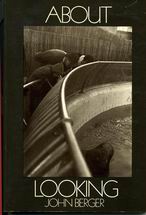

|
|

About Looking
Berger, John
Publisher: Pantheon Books, New York, USAYear Published: 1980 Pages: 198pp ISBN: 0-394-73907-8 Library of Congress Number: N71.B398 Dewey: 701.15 Resource Type: Book Cx Number: CX6150 A collection of essays covering a wide range of topics from photographs and media, to zoos and forests, grouped around the theme of how people look at things. Abstract: John Berger is one of Britain's most influential art critics and a well-known novelist and film scriptwriter. His book, About Looking, is a collection of essays written over a period of ten years and covering a wide range of topics from photographs and media, to zoos and forests. Each essay is about how people look at things, what particular people see when they look at something specific like immigrants looking at New York or peasants viewing fields, and how these perspectives are reflected in the works of artists. The book is partially illustrated and contains some very interesting observations on aspects of everyday life. The reader is told, for instance, that the manufacture of realistic animal toys began around the same time as the establishment of public zoos and that this was no coincidence. The first section, "Why Look at Animals?" looks at zoos and their significance in detail while the second section, titled "Uses of Photography," deals with the significance of certain photographers' work. The last and longest section, "Moments Lived," is mostly about painters including, but not limited to, Jean-Francois Millet, Seker Ahmet Pasa, Ralph Fasenella and Georges de La Tour. There are also essays on the sculptors Rodin and Romaine Lorquet. [Abstract by Nabeeha Chaudhary] Table of Contents Why Looking At Animals? Uses Of Photography The Suit and the Photograph Photographs of Agony Paul Strand Uses of Photography Moments Lived The Primitive and the Professional Millet and the Peasant Seker Ahmet and the Forest Lowry and the Industrial North Ralph Fasanella and the City La Tour and Humanism Francis Bacon and Walt Disney Article of Faith Between Two Colmars Courbet and the Jura Turner and the Barber's Shop Rouault and the Suburbs of Paris Magritte and the Impossible Hals and Bankruptcy Giacometti Rodin and Sexual Domination Romaine Lorquet Field Excerpts: The suit, as we know it today, developed in Europe as a professional ruling class costume in the last third of the 19th century. Almost anonymous as a uniform, it was the first ruling class costume to idealise purely sedentary power. The power of the administrator and conference table. Essentially the suit was made for the gestures of talking and calculating abstractly. (As distinct, compared to previous upper class costumes, from the gestures of riding, hunting, dancing, duelling.) ... The physical contradiction is obvious. Bodies which are fully at home in effort, bodies which are used to extended sweeping movement: clothes idealising the sedentary, the discrete, the effortless. ... The working classes - but peasants were simpler and more naïve about it than workers - came to accept as their own certain standards of the class that ruled over them - in this case standards of chic and sartorial worthiness. At the same time their very acceptance of these standards, their very conforming to these norms which had nothing to do with either their own inheritance or their daily experience, condemned them, within the system of those standards, to being always, and recognisably to the classes above them, second-rate, clumsy, uncouth, defensive. That indeed is to succumb to a cultural hegemony. ... The industrialised, "developed" world, terrified of the past, blind to the future, lives within an opportunism which has emptied the principle of justice of all credibility. Such opportunism turns everything - nature, history, suffering, other people, catastrophes, sport, sex, politics - into spectacle. And the implement used to do this - until the act becomes so habitual that the conditioned imagination may do it alone - is the camera. Subject Headings |